
Tribute to Philip F. Wight VS6DR
PHIL WIGHT, VS6DR -- A DX ORIGINAL
Philip Franklin Wight, Jr,
W5UHK, VS6DR, K9KVC (1958 Chicago).
He was born November 10, 1938 in Oklahoma, and passed away June
7, 1997.
It was with great sadness that I put down the telephone on Saturday morning June 7 (1997) after having just been informed by Chester Lunsford, XV5AC/W4EVG, that Phil Wight, W5UHK/VS6DR, had died that morning at the age of 58.
I hasten to add that there is a lot about Phil that I don't know and probably a lot that I have forgotten too, and there are probably others around who could fill in many other details, but here goes:
I first got to know Phil in 1968 when I was assigned by the U. S. Information Agency to the U. S. Information Service office in the city of Chiang Mai in Northern Thailand's Golden Triangle area. Though amateur radio was nominally illegal in Thailand in those days, thanks to the research carried out by another DX'er who I have really been missing for the past 10 years, Don Riebhoff, K7ZZ/HS3DR/HS4ABM, who was assigned to Thailand several months before I was, I knew by the time I was ready to ship my stuff to Thailand that in fact it was possible to get on the air there, and so I put a Drake line and NCL-2000 amplifier in my household effects shipment to Chiang Mai, along with a 14AVQ vertical and odds and ends of coax and wire.
Sure enough, through the good offices of the late Thai Police Lieutenant Chankij Boonyaratvej, HS1CB, I was issued the call sign HS3AL by the Society of Thai Amateur Radio (STAR) of which he was President, and once my gear arrived I put the vertical up on my house in Chiang Mai and I was on the air. I noticed at once that one of the more active stations in the area was one VS6DR out of Hong Kong. Since HS1CB had asked those of us operating from Thailand to stay on SSB, since he was not about to try to tune through the CW band to try to find an HS station that might be operating there when on SSB a voice provided instant ID of the 15 or so of us that were privileged to be operating from Thailand at the time, an awful lot of evening on-the-air time was spent just rag chewing in round tables on 20 meter SSB with other stations in the area, most prominently VS6DR, who styled himself as the "biggest DX'er in the Orient" not because his country total was the highest -- though he wasn't far behind the leaders -- but because his approximately 500 pound bulk cut an imposing figure at radio club meetings in the area. He even topped the famous "Big John" Van Lear, VE7IR/YB0AAA -- another good friend who, sadly, has passed on since -- who only ran to about 330 pounds or so.
Phil was an excellent operator and at that time was one of the high scorers in the area in many of the major contests. Don Riebhoff had already visited Phil in Hong Kong so it was only natural that the first vacation I took after arriving in Thailand was a trip to Hong Kong, where Phil met me at the airport in his chauffeur-driven Rolls Royce with the specially-outfitted back seat to allow Phil's bulk to be transported around town in regal comfort. We headed for Phil's town house apartment on Victoria Peak. Phil leased the whole top floor of about a four-story building at the very top of Victoria Peak. One of the first things we did on arriving at Phil's place was to go to the roof where I was given a guided tour of the VS6DR rooftop antenna farm -- a tribander and wires at the very top of the local topography, with an unobstructed 360 degree view of the horizon. I watched in amazement as aircraft lining up to approach Hong Kong's Kai Tak Airport circled the colony at altitudes well BELOW the altitude we were standing at.
The Victoria Peak residence came with its own Phil Wight story. Hong Kong was under rent control at the time, and so Phil's Chinese landlord was forbidden to raise his rent unilaterally. When Phil initially moved there the rent was fairly expensive as Hong Kong rents went, but once the real estate market took off -- too much money chasing too few available apartments -- Phil ended up with a real bargain, and refused to accept a significant rent increase. Thus the landlord took the only legal step available to him -- he tore the building down and built a new one. Phil eventually had to move downtown to a much less desirable DX QTH.
Phil was an excellent cook and as I recall he whipped up a first-class Mexican dinner for the two of us, and in a conversation that went well on into the night I began to learn a little about my fascinating host.
My first surprise was that Phil was actually a couple of years younger than I was -- I was only 31 at the time -- and yet he was already an experienced hand in the Oriental colony's business circles. He was the Chairman and CEO of Pacifica Products, Ltd., and, despite the fact that it was still about three years before the USA recognized the Peoples' Republic of China, Phil was already doing big business with the "mainland".
Phil was one of those people you meet in your lifetime who had absolutely no fear of failure. He was willing to try anything that seemed promising, and his business sense proved to be right on the money most of the time. Though a congenial and gracious host, he evidently could throw his considerable bulk around in the business world when he had to. He had begun his working life as a bass player with a band in a Las Vegas casino, and somehow found his way to Hong Kong while still a very young man -- I never heard exactly how.
He was a specialist in finding a business "niche" where there was a demand and no one was fulfilling it. I am sure I don't know the half of what his dealings with the PRC amounted to, but one big profit center was his purchase of human hair from PRC traders which eventually found its way to hairbrush manufacturers in the States.
In succeeding years Phil even utilized his knowledge of Las Vegas to charter aircraft so that high rollers from Hong Kong's business elite could travel non-stop to Las Vegas in style and gamble to their hearts' content. However that business generated so much loose cash that some of Phil's employees were tempted to get light-fingered, and he eventually dropped that line of endeavor.
Of more interest to me was the fact that Phil was astute enough to obtain for Pacifica Products the exclusive franchise for all of China from several Japanese radio manufacturers, who had no objection to granting such a franchise since everyone knew that the Chinese Government couldn't afford to buy modern radios anyway. A few years later when the Peoples' Liberation Army modernized its communications systems, Phil literally "cleaned up" with the commissions he received.
My days during my stay in Hong Kong were spent using Phil's downtown office as headquarters for my foray into Hong Kong's commercial districts where I had several suits made to order for a pittance of what they cost in the states, and otherwise watched in fascination as Phil spent his days signing contracts and business letters put in front of him in myriad folders by his faithful secretary Ceci, who he later married.
On one of the evenings I was there he took me over to the China Fleet Club where the Hong Kong Amateur Radio Transmitting Society was having its weekly session of the DXers' Liars and Barfly Society -- not a real club meeting but sort of a "can you top this one?" bull session complete with plenty of Gilbey's Gin and Schweppes Quinine Water flowing as the tropical night went on.
Also by this time Phil had begun a ham radio magazine in Hong Kong called OHM (for Oriental Ham Magazine), which gave a number of us expat hams in the Orient a chance to become authors for the first time in our lives. There was no pay involved, but it was still nice to see one's name on the byline of an article which was circulated all over the world. Imagine my satisfaction when an article I wrote about the ITU banned country list actually drew a response from Dick Baldwin, W1RU, then the ARRL's Assistant General Manager (and now, of course, the President of IARU).
It was not long after my return to Thailand that Phil began making ever-more-frequent visits to Thailand, and if Don and I could get to Bangkok on such occasions we would. Most of our time there was spent on guided tours of Bangkok night life provided by the radio club President Lt. Chankij, who of course as a police detective knew where the action was. This being a family list, I will go into no graphic descriptions of what happened, except to say that Phil was an enthusiastic participant in whatever it was that we did on such occasions, despite the skepticism of some business owners as to whether his size would allow him to fully participate in all of the evening's activities.
Following our diplomatic assignments in Thailand, both Don Riebhoff and I were transferred to Viet Nam, where there was a war going on at the time and the U.S. Government made it rather clear that if you wanted to continue to have a career in the U. S. Diplomatic Service, a tour as a civilian advisor in Viet Nam would have to be served eventually -- why not now?
Naturally Don and I started working on getting ham radio legalized in Viet Nam and OHM Magazine was a big ally in our efforts, lending its pages to whatever we wanted to write about what we were doing. Don and I met Chester, W4EVG, who was already in Viet Nam when we arrived, literally by following the coax lead-in from a monstrous 4-el quad on top of an American Government apartment building to the apartment where it entered the building. Chester, who was to have the major role in establishing the first legal ham station in Viet Nam in many years, was a new enlistee in the "Phil Wight Fan Club" and in Phil's final years he had no more loyal friend than Chester, who held Phil's hand by e-mail more than the rest of us in order to try to keep Phil's mind off his health problems.
It was not long after our arrival in Viet Nam that Phil began making Saigon a regular stop on his business travels throughout the area. I'll never forget the time that Phil came down to Saigon on his way to the very first Southeast Asia Net Convention in Penang, Malaysia, so that we could all fly over to the Convention together. We were scheduled to fly Air Viet Nam to Bangkok, with a stop in Phnom Penh, and, after overnighting in Bangkok, to take a Malaysia-Singapore Airlines flight to Penang. We got to the Air Viet Nam check-in counter at Saigon's airport only to find that Phil was carrying no health card showing that he had been vaccinated against yellow fever. Thailand was rather strict at the time about not allowing people to enter its territory from war-torn places like Viet Nam without health certification, and Air Viet Nam was not willing to let Phil board the flight without one, since they might be forced by Thai authorities to return him to Saigon from Bangkok free-of-charge. Never in my life have I argued so tenaciously with airline officials as on that occasion; we couldn't conceive of being at the SEANET Convention without our big friend. Finally I got the airline to produce a release-from-liability form -- which it turned out they had all along -- and once Phil signed it we were on our way. Oh, yes -- the Thais never asked him about his health!
On our stop at Phnom Penh airport we stood under the wing of the 727 on the tarmac waiting until the local passengers were ready to board -- since there was no power truck keeping the plane cool while it was on the ground -- fantasizing about one day getting Cambodia on the air as well. Not long thereafter, "Big John" Van Lear -- who was the one who organized this first SEANET Convention -- managed to accomplish that feat.
We stayed that night in the Monthien Hotel in Bangkok. My memories of what happened that night are fuzzy, but the next morning I joined Phil in his suite for breakfast, which he ordered delivered to his room, and I remember that for the first time in my life I saw one of those extra-long shoe horns which was how Phil got his shoes on in the morning. Having expanded my girth considerably in recent years, I now utilize such an apparatus myself.
Off we went to Penang and the convention, and we had a great time - - all 17 of us. Ed, W2MIG, who was 9V1QD at the time, was another one of the participants.
I left Viet Nam just after Chester had managed to get the first legal ham station going there, but Don and Chester stayed on, and Phil Wight got very interested in getting the Spratly Islands on the air. He devoted several issues of OHM Magazine almost single-mindedly to the effort, and even went along on the first, abortive DX-pedition, though he had to stay on the mother ship because if he had tried to get off on the dinghy it probably would have tipped over. On succeeding efforts, including the successful one, Phil was satisfied to cheerlead on 20 meters from his shack in Hong Kong, but there is no doubt that his enthusiasm helped drive the effort to its eventual success when Chester and Don along with WB4UZP, N5TP and WB4VBY -- made several thousand QSO's from one of the Spratlys.
I had only had sporadic contact with Phil after that until last summer, though mutual friends had told me about encountering Phil in his electric vehicle prowling the exhibit floor at electronics conventions. Among those keeping me informed of Phil's activities was Phil's long-time accountant, Vince Chinn, K6KQN. Then last summer, inasmuch as I was going to be in the San Francisco area for the World Radiosport Team Championships anyway, my XYL Somporn and I accepted a long-standing invitation to be house guests of Phil's. By this time Phil had been having serious health problems for years, and though Pacifica Products was still going great guns in Hong Kong, Phil was a virtual shut-in at his house in Mountain View. Immobile as he was, his old brain was still racing ahead as always, and it wasn't long before I had forgotten his infirmities as we got caught up in a passionate review of what had happened since we had last seen each other in Bangkok in 1979, during my second tour of duty in Thailand. I am really pleased that my XYL Somporn got to meet him and see what a great guy he was.
One final anecdote illustrates the way Phil went about doing things in his own original way. I happened to remark that his home telephone and fax numbers both seemed like the kind of numbers that would be assigned to the switchboard of a major business or government establishment -- numbers like 568-9600 and 568-9400. He answered that when he had moved into the house he had programmed an automatic dialer to dial every number ending in "double-zero" in the area, and finally he found two such numbers where an automatic recording informed him that "the number you have dialed is no longer in service." He then asked the phone company for those numbers and got them.
Unfortunately our stay as Phil's house guest was all too brief, as the very next day Phil was ordered by his doctor to go back into the hospital. After I left for the WRTC festivities that day, I never saw my friend in person again, though Somporn stayed at the house that day and accompanied him to the hospital. I now regret not having made a final effort to get by the hospital to see the old boy.
A real original has passed from among us, someone who vastly enriched the lives of every one he touched. RIP, Phil Wight!

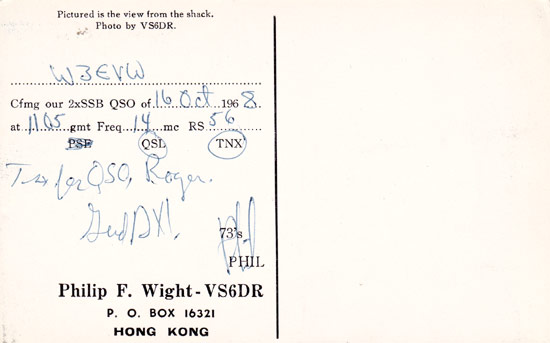
VS6DR 1968
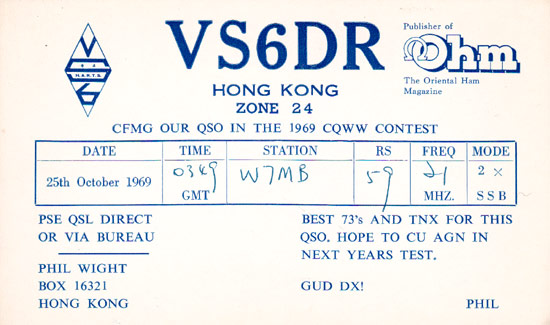
VS6DR 1969
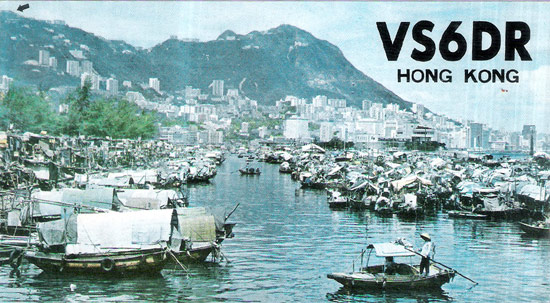
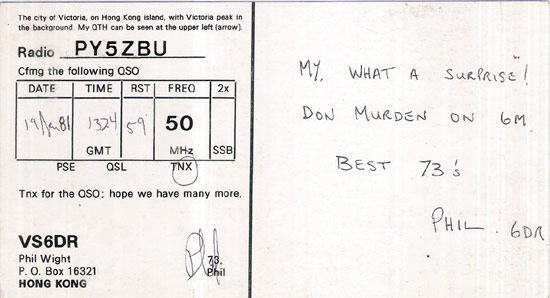
VS6DR 1981

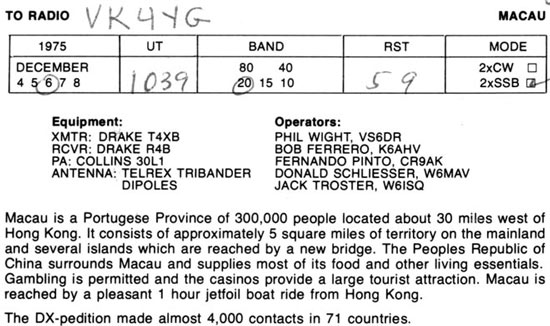
CR9AK 1875 Macau with Phil pictured on the left!

Fred Laun XV4AL (K3ZO), Barry 3W8B, Gene KR6FC, Don Riebhoff 3W8D (K7ZZ, K7CBZ), Phil Wight VS6DR
From OHM Magazine

The photo was taken at the China Fleet Club at an annual Hamfest of HARTS 1957. Starting with Luke VS6AZ in the foreground and going clockwise VS6OQ, Pat O'Brian VS6AE, VS6DK and XYL, VS6CV and XYL, BV1US, VS6BE Lyell, XYL of VS6DR, VS6DR and friend.
The man who once billed himself as
"the biggest DXer in the Orient," Phil Wight,
W5UHK/VS6DR, of Mountain View, California, and formerly of Hong
Kong, died June 7. He was 57. DXer Fred Laun, K3ZO, who spent
some time in Asia himself, explains that Wight's
"approximately 500-lb bulk cut an imposing figure at radio
club meetings in the area." Laun says that Wight, who became
the chairman and CEO of Pacifica Products Ltd., had begun his
working life "as a bass player with a band in a Las Vegas
casino, and somehow found his way to Hong Kong while still a very
young man." He also founded OHM (Oriental Ham Magazine) as a
service to American and other English-speaking hams who were
living in the orient. --Fred Laun, K3ZO, forwarded via the
Internet DX Mailing List.
--Published in The ARRL Letter, Vol. 16, No. 26, June 27, 1997.
Tnx W5KNE
The 1S1A February 1973 Spratly Island DXpedition on Youtube. There is no audio on this video but still very much worth watching! Phil went along on the 1st abortive attempt and was very supportive in his OHM Magazines (Oriental Ham Magazine) and from his station VS6DR.
Here is the 1S1A
story in the March / April 1973 OHM
Magazine.
"Spratly Keeps Its Secrets" Article in November 1969 OHM Magazine.
There are several other OHM Magazine articles on Hamgallery. Go to http://hamgallery.com and type in OHM in the search engine near the top of that page, hit enter, wait until you get a page of links to the OHM Magazine articles!
Be sure to read "Trip Down Memory Lane" about Hong Kong and Southeast Asia by K8MFO, K3ZO!
Tribute courtesy of K3ZO
1968 VS6DR QSL from the estate of W3EVW
1969 VS6DR QSL K8CX Collection
1981 VS6DR QSL courtesy of VS6AM / G3MWM / PY5ZBU
CR9AK QSL, HARTS 1957 Photo, courtesy of VK4TL / VS6CW
"Trip Down Memory Lane" article courtesy of K8MFO, K3ZO
OHM Magazine stories courtesy of K3ZO
Some info courtesy W5KNE
Tnx The ARRL Letter
This site is
copyright © by K8CX of Paradox Design Group (PDG).
All Rights Reserved. All art, photos, and html is property of
PDG.